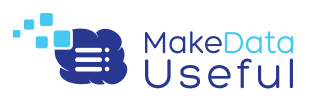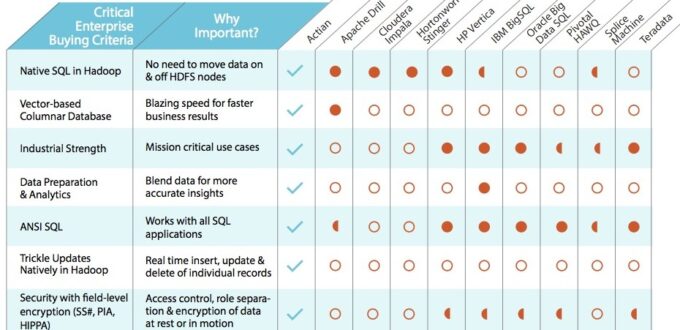Drowning while trying to understand your options for SQL-based database management in Hadoop? This graphic is a simplified comparison of the various features of several popular products being used today. I outline some of my biggest differentiators in this post.
While this is a marketing slide for Actian’s SQL in Hadoop enterprise solution, I wish I saw it earlier so I could understand the Hadoop ecosystem more clearly. For example, two common areas of concern/confusion with people I speak to are reliability and ACID-compliance. However, when we are talking it becomes clear that many users believe that they have to be beta testers and accept instability while also compromising their functional needs.
Industrial Strength SQL in Hadoop
Many Hadoop-based options are so new that they should not be called “enterprise ready“. Some solutions have been running for much longer than others. With many of the newest companies there has not been enough time to have implemented all standard security, stability and high availability requirements that architects have been building on top of for the last two decades.
Anyone who switches their analytic workloads over to Hadoop will desire to leverage their existing SQL applications. Who wants to throw away their business intelligence solutions or custom analysis when migrating to Hadoop? Instead, most are needing solutions that support full ANSI SQL capabilities, not a subset of SQL or one that requires special tweaks to optimise.
[ I’ll write more in another post about the common database development barriers that every start-up platform will hit when trying to get to industrial status – leave a comment if you’d like to hear about it sooner than later. ]
ACID Compliant SQL in Hadoop
Sitting between both the “enterprise ready” and “full SQL” issue is the ACID-compliant support for full read, write, update and delete. Some solutions are only providing a SQL query layer on top of data that cannot be updated (or worse, cannot even join tables).
At the end of the day, you can still try to move enterprise analytic workloads into Hadoop but if you are missing the enterprise features expected from a SQL solution then you won’t have a full solution.
This graphic can be updated to include more solutions today, as new options are coming online every month, but there will still be only a few that check off a majority of the boxes.
For a more in-depth review see Actian’s SQL in Hadoop Buyer’s Guide.
- Geography + Data - July 15, 2021
- DIY Battery – Weekend Project – Aluminum + Bleach? - January 17, 2021
- It’s all about the ecosystem – build and nurture yours - May 1, 2020
- Learnings from TigerGraph and Expero webinar - April 1, 2020
- 4 Webinars This Week – GPU, 5G, graph analytics, cloud - March 30, 2020
- Diving into #NoSQL from the SQL Empire … - February 28, 2017
- VID: Solving Performance Problems on Hadoop - July 5, 2016
- Storing Zeppelin Notebooks in AWS S3 Buckets - June 7, 2016
- VirtualBox extension pack update on OS X - April 11, 2016
- Zeppelin Notebook Quick Start on OSX v0.5.6 - April 4, 2016


